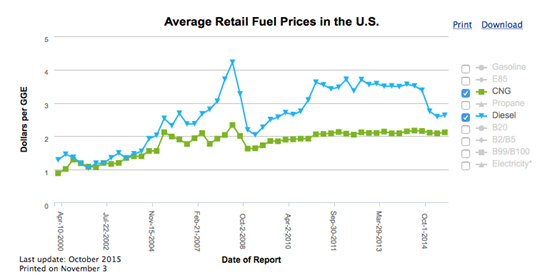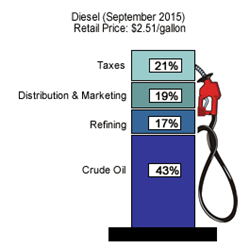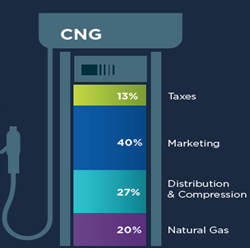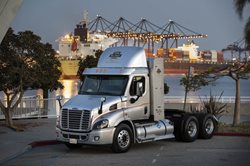
With the workshops I have been participating in for the SoCalGas Company and SDG&E (San Diego Gas & Electric) coming to a close for the year, I took some time to reflect back and think of some of the important things that were asked during these sessions that I was asked to speak at. With somewhere between 30-50+ fleet owners attending each session, all with a common interest of pursuing natural gas heavy-duty and medium-duty truck additions to their fleets, I was asked many great questions as to the benefits and disadvantages to incorporating CNG from an actual motor carrier’s perspective. Of all the questions I heard though, the question regarding the comparison of CNG to diesel was probably the most popular of them all, given the historic low prices of diesel at the pump lately.
When I considered switching to CNG from diesel, I will admit that the $4.00+ per gallon fuel prices for diesel at the time made $2.00 per gallon CNG that much more appealing. Not one to act on a whim or plan only for the short-term, I instead took a look at several factors that one should consider when making the switch to add CNG trucks. The first long-term piece of research I did took a look at both the past and present trends in both diesel and CNG. The picture below gives a little look into what helped me decide that I was ready to get off of the diesel fuel roller coaster. Unless the bottom of the crude market falls out from under it, it is a pretty safe assumption that we are nearing the bottom of the record low diesel prices we are currently seeing. You know what they say about the bottom, “There’s nowhere to go but up!”
 Source: Clean Cities Alternative Fuel Price Reports
Source: Clean Cities Alternative Fuel Price Reports
The second major consideration I had to take into account was where the bulk of the fuel commodity was coming from? Although we produce some crude oil domestically, we still rely on other countries to supply a great deal of it to meet our everyday needs. Diesel’s reliance on that crude makes it highly susceptible to fluctuation as a result. Different world and market events being able to easily influence the price of diesel in this manner increase its price volatility. This can result in substantial price change overnight without much notice to the consumer. Natural Gas is a domestically produced fuel here in the United States, in which the production far exceeds the current demand. This surplus of natural gas, matched with the stability of being a domestic fuel, make it far less susceptible to erratic price fluctuations.
The third and final consideration in my long-term research in price difference was seeing what actually went into a gallon of each type of fuel. By considering this, I was not actually looking to investigate the refining and chemical make-up of each fuel, but rather wanting to find out where my money was going when purchasing a gallon unit of each. The two pictures below illustrate the average cost breakdown of a gallon of each type of fuel. As you can see, a large bulk of diesel fuel is made up of the crude price, which accounts for its price volatility to a large extent. Taxes account for the second highest “chunk” of what makes up diesel at 21%, which you would probably agree that we will see increase and not decrease in any future timeframe. In comparison on the CNG chart, you may notice that only 20% of the cost of CNG is made up of the actual natural gas, which is more stable historically in price anyway. The bulk of CNG cost is comprised up of Marketing (40%) and Distribution & Compression (27%), for a total of 67% of the total cost. In my own decision, I estimated that marketing for CNG was bound to decrease eventually over time as it becomes better known and more widely used regularly. The marketing for CNG is very high at this time because it is a newer alternative to domestic fuel and money has to be spent to “get the word out.” I also figured that as technology progresses in the world of natural gas, cost from efficiency in distribution & compression ultimately will help reduce that cost factor in the equation.


Source: eia.gov Source: American Gas Association 2015 Playbook
Although the hidden worry could be seen in the faces of the fleet owners at the workshops, my job was not to help talk them into natural gas. Rather, I was their to help them understand the research it takes to determine if a natural gas truck was right for their fleet by taking a look at what I have done. I will boldly state that natural gas trucks are not for everybody, or even for every operation. The key to tapping into natural gas savings lies in doing the homework ahead of time. As for me, I am looking forward to my

continued operation of a CNG-powered Freightliner Cascadia. Doing the research and taking price fluctuation and price make-up into account before I made the decision to take on natural gas, have helped me unlock the current savings from CNG in comparison to diesel. It has also helped better prepare my business for what is to come and to know that there will be increased benefits when diesel begins its next ascent to the top!